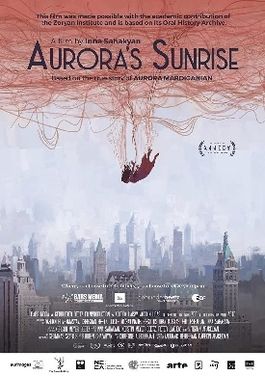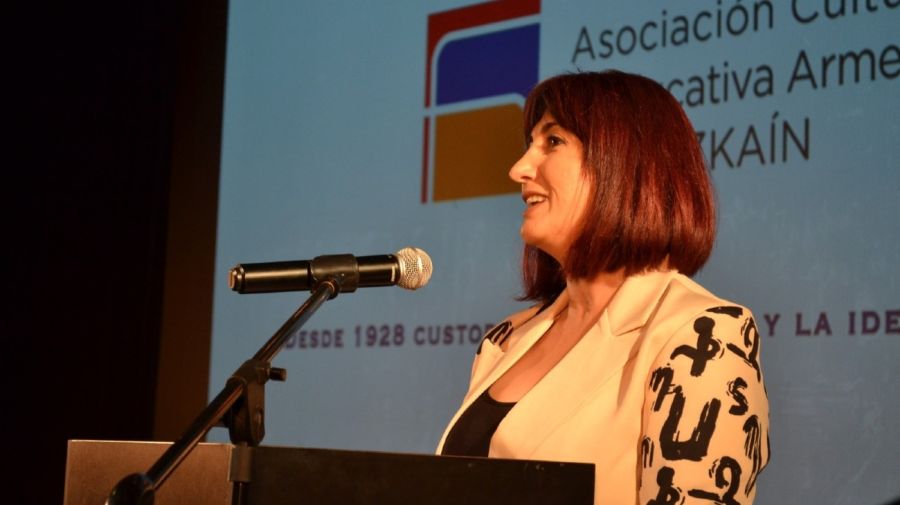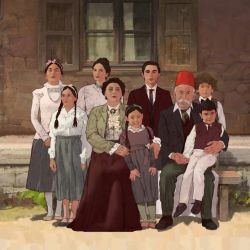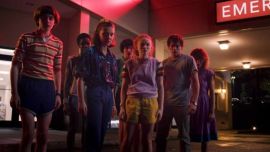The Armenian Cultural Centre in Buenos Aires buzzed with a palpable mix of excitement and anticipation. A sold-out crowd had gathered on a Saturday evening for a screening of a powerful film that is as extraordinary as it is affecting.
Aurora's Sunrise, Inna Sahakyan's powerful animated documentary, tells the extraordinary story of Aurora Mardiganian, a woman who survived the Armenian Genocide and went on to become a Hollywood star, using her platform to bring a nearly forgotten chapter of history to light.
In 1915, the Ottoman government began a systematic extermination of its Armenian population. It started on April 24, known as “Red Sunday,” with the arrest and execution of hundreds of Armenian intellectuals and community leaders. Armenian men were then forced into labour battalions and ultimately executed. Soon after, the remaining Armenian population – mostly women, children, and the elderly – were driven into the Syrian Desert on brutal death marches. Starvation, exhaustion, mass shootings, and torture were their constant companions. By the end of this campaign, an estimated 1.5 million Armenians had perished.
To this day, the Turkish government denies the genocide, refusing to acknowledge its scope and intent. But for Armenians, the genocide is an indelible wound – a painful yet unifying part of their history that fosters a shared identity and resilience.
Aurora's Sunrise serves not only as a tribute to Aurora Mardiganian's courage, but also as an act of cultural preservation, ensuring that the history of Armenia is not forgotten. The film masterfully blends archival interviews and surviving footage from Auction of Souls, the 1919 silent film starring Aurora herself.
Sahakyan brings Aurora's story to life with sensitivity and urgency, reminding us of the vital role storytelling plays in keeping collective memory alive. But the film is more than a historical account – as Sahakyan emphasised in the post-screening discussion, it carries a powerful message for today: a call to action for Armenians worldwide.
“We need global outreach,” she urged. “This film is about educating others on the issues that threaten Armenia's existence today.”
Across generations
The diverse audience of children, parents, teachers, and community leaders present at the screening underscored the importance of sharing Aurora's story across generations. Despite the film's harrowing subject matter, a collective understanding filled the room: this history, no matter how painful, must be remembered and passed on.
This sense of duty to remember is deeply intertwined with the broader story of the Armenian Genocide, an atrocity remaining largely unknown outside of Armenian and Turkish communities.
In Argentina, the trauma is well-remembered. The South American nation is home to the third-largest Armenian diaspora in the world, numbering more than 100,000 people, and in 2007, Congress formally recognised the events of 1915 as a genocide.
In creating Aurora's Sunrise, Inna Sahakyan combined archival interviews with genocide survivors, historical footage and personal testimonies which vividly recount the horrors endured by Armenians. However, the film goes beyond documenting history; as Sahakyan emphasised, it stands as both a poignant reminder and an urgent call to action for Armenians worldwide — to remember their past, educate others and advocate for the recognition of the mass killing.

The film’s unique animation style plays a crucial role in achieving this mission by making Aurora’s story accessible to younger generations. "The 'docu-animation' style appeals to a younger audience," Sahakyan explained. "Heavy topics like genocide can be overwhelming for young viewers but animation provides a familiar and engaging medium." Through this approach, she explained, the film ensures that the legacy of resilience and resistance will continue to resonate with future generations.
The director also drew a striking parallel between the global silence during the Armenian Genocide and the current lack of attention to the ongoing conflict between Armenia and Azerbaijan. The two former Soviet republics have been at war for decades over Nagorno-Karabakh, a breakaway ethnic Armenian region in Azerbaijan.
Last year, Azerbaijan sent in troops to seize back the area, whose entire population of nearly 120,000 people fled to Armenia. Authorities warn of “the threat of ethnic cleansing,” a stark reminder of the existential risks that linger today.
"People are lost in the multitude of global conflicts," noted Sahakyan. "It’s heartbreaking that Armenia, being a small country, doesn’t receive the attention it deserves." For many
Armenians, she argued, echoes of the genocide persist — a sense of a lost homeland, an endangered identity, and the continual struggle to survive against formidable odds.
Precarious
The Armenia-Azerbaijan conflict is rooted in deep-seated ethnic and territorial disputes, particularly over Nagorno-Karabakh. Assigned to Azerbaijan during the Soviet era, Nagorno-Karabakh became a focal point of conflict after the USSR's collapse, leading to a brutal war in the early 1990s. Armenian forces then gained control of Nagorno-Karabakh and adjacent areas, displacing many Azerbaijanis.
Today, Azerbaijan leverages its oil wealth to boost its military and geopolitical influence, while Armenia faces economic and political struggles. Sahakyan views this moment as pivotal in her nation’s history — a time that will shape the nation’s future amid regional tensions and shifting power dynamics.

Sahakyan’s final words underscored the urgency of Armenia’s current struggles.
"This situation needs the same urgency as 1915 because of my country’s vulnerability today," she told those gathered to watch the film, her voice filled with determination. She urged the Armenian diaspora to harness its global influence to raise awareness of the country’s present geopolitical challenges, drawing a powerful connection between historical and contemporary threats.
Amidst this precarious situation, Sahakyan finds strength in Armenian identity. Her portrayal of Aurora as a hero, not a victim, reflects her belief in the resilience of the Armenian spirit. "Aurora's story is about refusing to be a victim," she explained. "It's about turning pain into a force for hope – and that's exactly what we need to do now."
With its powerful message of resilience, and an urgent call to action, Aurora's Sunrise serves as a poignant reminder that the fight for recognition, justice, and self-determination continues. As Sahakyan declared, "We are not just survivors. We are fighters. We must continue to fight for recognition and the right to exist, thrive, and tell our stories on our terms."



























Comments